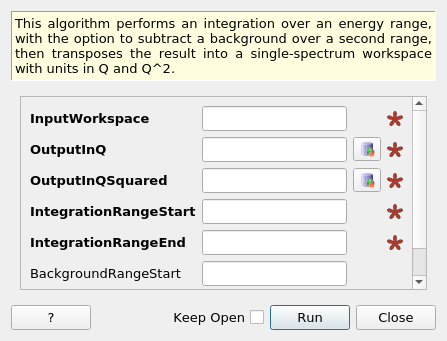\(\renewcommand\AA{\unicode{x212B}}\)
ElasticWindow v1¶

ElasticWindow dialog.¶
Summary¶
This algorithm performs an integration over an energy range, with the option to subtract a background over a second range, then transposes the result into a single-spectrum workspace with units in Q and Q^2.
See Also¶
Properties¶
Name |
Direction |
Type |
Default |
Description |
|---|---|---|---|---|
InputWorkspace |
Input |
Mandatory |
The input workspace. |
|
OutputInQ |
Output |
Mandatory |
The name for output workspace with the X axis in units of Q |
|
OutputInQSquared |
Output |
Mandatory |
The name for output workspace with the X axis in units of Q^2. |
|
IntegrationRangeStart |
Input |
number |
Mandatory |
Start Point of Range 1 |
IntegrationRangeEnd |
Input |
number |
Mandatory |
End Point of Range 1 |
BackgroundRangeStart |
Input |
number |
Optional |
Start Point of Range 2 |
BackgroundRangeEnd |
Input |
number |
Optional |
End Point of Range 2. |
Description¶
This algorithm Integrates over the range specified, converts the spectrum axis into units of Q and Q^{2} and transposes the result workspaces.
There are two output workspaces.
Workflow¶
Usage¶
# Prepare a workspace that has all necessary settings to work with ElasticWindow
ws = CreateSampleWorkspace(Function='User Defined',
UserDefinedFunction='name=Lorentzian,Amplitude=100,PeakCentre=27500,FWHM=20',
XMin=27000,
XMax=28000,
BinWidth=10,
NumBanks=1)
ws = ConvertUnits(ws, 'DeltaE',
EMode='Indirect',
EFixed=1.555)
ws = Rebin(ws, [-0.2,0.004,0.2])
SetInstrumentParameter(ws, 'Efixed',
DetectorList=range(100,200),
ParameterType='Number',
Value='1.555')
# Run the algorithm
q, q2 = ElasticWindow(ws, -0.1, 0.1)
print(q.getAxis(0).getUnit().caption())
print(q2.getAxis(0).getUnit().caption())
q
Q2
Categories: AlgorithmIndex | Inelastic\Indirect
Source¶
C++ header: ElasticWindow.h
C++ source: ElasticWindow.cpp
